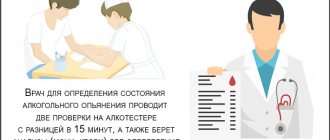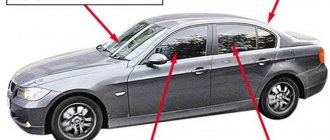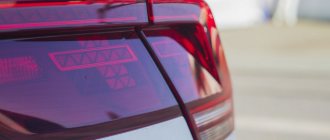Tinting allows you to hide from prying eyes and leave personal belongings and technical devices in the cabin - a radio, video recorder or radar detector. In Russia, tinting of front windows is officially allowed when the light transmittance is at least 70%. Workshops offer a wide range of services and film tinting with much lower throughput. The demand is generated by the fact that it allows the owner to remain incognito. However, there is a penalty for this. What exactly is it and is there a chance to avoid it? Let’s look at it below.
Fine for darkening windows not according to regulations
In 2010, Article 12.5 of the Code of Administrative Offenses was supplemented by Part 3.1, according to which driving a car with windows that do not comply with technical regulations leads to a fine of five hundred rubles (and for repeated violations, the amount does not change). You can pay for it with a 50% discount.
The punishment should not be made more severe at the request of the traffic police, that is, by law you cannot be forced to remove the film on the spot. Although in practice this also happens: the driver signs a resolution, as if agreeing that a violation has taken place, and then the officer demands to “stop illegal actions” (under Article 3 of Federal Law No. 3 “On Police” of 2011) and eliminate the cause violations on site. This is not entirely true, since according to this law the driver only needs to stop operating the vehicle, that is, stop and park, and not remove the film.
Another measure that can be taken against a driver driving a vehicle that is not tinted according to GOST is an inspection of the car and subsequent arrest for 15 days. The basis is disobedience to a police officer under Part 1 of Article 19.3 of the Code of Administrative Offences. However, such a detention or a fine of 500 to 1000 rubles will be illegal, since the requirement to remove the tint is not specified in any law. Consequently, the employee commits arbitrariness under Article 19.1 of the Code of Administrative Offenses and you can write a complaint against him to the traffic police and file an application in court.
In 2021, the State Duma is discussing a bill according to which the punishment for tinting should become more serious. At the same time, this measure will help minimize the situations of lawlessness described above. The fine for the first violation will be one and a half thousand rubles, a second violation will be five thousand rubles, a third will be deprivation of the driver’s license from 2 to 6 months, BUT THIS IS JUST DISCUSSED IN THE STATE DUMA AND HAS NOT COME INTO FORCE!
What is the punishment for violating the tinting rules?
A citizen who installs glass on a car or fixes a film that does not comply with the norms of current legislation is given a fine. The amount of the penalty is 500 rubles. Under paragraph 3.1 of Article 12.5 of the Code of Administrative Offenses of the Russian Federation, no other enforcement measures are provided. The citizen is not arrested, the car is not sent to the impound lot.
A traffic police officer who discovers a violation has the right to demand that the driver eliminate it. It takes 10 days to remove tinting and replace glass. If after the specified period it is discovered that the citizen ignored the inspector’s instructions, he will be held accountable under paragraph 1 of Article 19.3. It was amended by Federal Laws No. 57-FZ of 04/29/2006, No. 4-FZ of 02/07/2011, No. 227-FZ of 07/03/2016.
The document provides for the following penalties:
- Assignment of a fine. The amount of the penalty is 500-1000 rubles.
- Administrative arrest. The person is taken into custody for up to 15 days.
If the driver continues to ignore the requirements of the traffic police officers, continues to use a car with windows or tinting that does not comply with the established standards, the enforcement measures will be tightened. The violator is punished under paragraph 6 of Article 19.3 of the Code of Administrative Offenses of the Russian Federation, introduced by Federal Law No. 258-FZ of July 21, 2014.
The document provides for liability in the form of:
- prescriptions in the amount of up to RUB 5,000;
- imprisonment for a period of up to 1 month.
These sanctions apply to individuals. Violators with a different status are subject to a fine:
- responsible employees - 10,000-20,000 rubles;
- companies - 50,000-100,000 rubles.
If the driver does not pay the penalty within 60 days established by current legislation, punitive measures are applied to him under Article 20.25 of the Code of Administrative Offenses of the Russian Federation.
This regulatory legal act provides for the following sanctions:
- a fine of two times the amount of the imposed penalty, but not less than 1000 rubles;
- compulsory work up to 50 hours;
- arrest up to 2 weeks.
If a citizen continues to fail to pay the fine, the punishment will be increased.
Which option is acceptable?
What car windows should be like is regulated by the following documents:
- GOST No. 32565 “Safety glass for land vehicles”.
- Adj. 8 clause 4 of the technical regulations of the customs union “On the safety of wheeled vehicles”.
- Clause 7.3 Traffic Regulations of the Russian Federation.
These standards impose a number of requirements on car windows:
- Tinting is permitted if the light transmittance of the windshield and side windows of the front row is 70% or more;
- rear windows can be darkened as desired if rear-view mirrors are present;
- the thickness of the dark strip on top of the windshield is up to 140 mm;
- The use of mirror film for all glass without exception is prohibited.
Who takes measurements and issues fines?
To record a violation under Part 3.1 of Art. 12.5 of the Code of Administrative Offenses, the luminous transmittance of automobile glass must first be measured. This action can be carried out by:
- traffic police technical supervision is a body that checks whether a car meets technical requirements;
- An employee of the State Traffic Inspectorate (the check is carried out on the basis of Articles 23.3, 26.8, 28.3 of the Administrative Code).
Metering Tools
The luminous transmittance of glass is measured using a taumeter. The most popular companies in the Russian Federation are “Svet”, “Raster”, “Blik+”, “Blik-N” and “Tonic”.
The toilet meter operates from the car cigarette lighter. The meter voltage is usually 12 V with a deviation of no more than 0.6 V (2%).
The device must be sealed and have a tag with the time the serviceability was checked (no later than 1 year ago, at the moment).
Measuring rules
The driver has the right to demand from the inspector a document showing that he can carry out measurements properly, and a certificate of the meter confirming the device’s compliance with GOST.
The traffic police officer is required to record the data obtained during measurements.
Direct measurements are taken on washed and dried glass, at three points. Temperature, pressure and humidity indicators are preliminarily measured, which is due to the characteristics of the toilet meter in various weather conditions.
Average values for measurement:
- temperature from -10 to +40 degrees;
- humidity no more than 60%;
- pressure 86-106 kPa.
Thus, in rain, fog or frost, the measurements obtained may not correspond to reality. Although these indicators vary quite widely among different toilet meters. Thus, “Svet” operates in the range from -40 to +40 degrees, and “Blik-N” is capable of correctly measuring light transmittance even at 95% humidity.
Note that illumination does not affect the operation of the devices in any way, that is, the indicators will not differ in the light and dark hours of the day.
Grounds for imposing a fine for tinting
In order to find out what processes happen to cars on the roads that use window tinting, just go to the traffic police website, where all the information is presented in the appropriate section.
In order to comply with the requirements of the legislation that came into force on January 1, 2021, in all regions of the federation, special raids are carried out weekly by traffic police officers, which are aimed at identifying violations related to tinting car windows.
Before each such event, inspectors are informed that tinting is not a violation if the light transmission for the front side windows is at least 70 percent, and for the windshield - at least 75 percent.
Although, in the Technical Regulations this requirement for the windshield is specified in the parameters 70 percent. In this regard, a number of drivers have already tried to challenge the new requirements for light transmission, however, the courts emphasize precisely that the traffic rules contain a reference to the outdated GOST No. 5727 for 1988, which is canceled only to the extent that Window tinting is permitted.
That is, in terms of the fact that GOST prohibits the use of glass tinting, there is no cancellation. The same incidents occur when trying to appeal in court the process of checking vehicle windows for light transmittance.
Thus, for such a test, appropriate conditions must be created in terms of ambient temperature, atmospheric pressure and air humidity. This is provided for by GOST R 8.831-2013, as well as the Technical Regulations. These documents came into force on January 1, 2015.
According to their requirements, the measurement is made in relation to one point, using the arithmetic mean of three measurements.
However, when considering such cases in courts, practice is applied to the requirements of GOST, which relate to new vehicles. In this case, the laws of physics are ignored.
How to avoid fines
Even if the vehicle tinting does not comply with the established regulations, there are several loopholes that make it possible to evade payment. Let's consider several ways.
If measurements are not taken
It may turn out that the State Traffic Inspectorate inspector does not have a toilet meter. He will not be able to take measurements and will be forced to impose a fine of 500 rubles under another article of the Administrative Code - 12.5 part 1. However, if the motorist recorded the process of communication with the inspector on a video recorder, when appealing the fine it will be easy to prove that the employee can assess the light transmittance of the film “by eye” could not. Therefore, it is not a fact that it impeded the driver’s visibility and created a threat to the safety of the vehicle.
Article 12.5 shall apply to removable tinting that is considered a visibility-impairing condition.
If the measurement was taken in bad weather
The protocol specifies the name of the toilet meter used for measurement. Currently, no GOSTs have been developed that would regulate the weather conditions acceptable for measurements. Therefore, the instructions for the device are the only document on the basis of which you can try to appeal the fine.
It will be more difficult to avoid receiving a fine at the time a violation is recorded, since the inspector is not required to carry the instructions with him. You can find it on the Internet and challenge the punishment if the weather conditions do not meet the stated requirements.
If there are errors in the protocol or resolution
The likelihood of appealing a fine based on errors in procedural documents is quite low. Especially if the errors do not change the essence of the matter - for example, the name of the offender or address is incorrectly indicated.
The chances are slightly higher when the inspector incorrectly records the light transmittance of the glass or vehicle data. In this case, the court or the traffic police may side with the driver and cancel the decision.
If you don't roll up the windows
The driver may refuse to raise the front windows when detained by traffic police officers in order to hide the fact of tinting. Of course, this is only relevant if the windshield is not tinted. It is worth understanding that if you refuse to comply with a legal requirement, the inspector has the right to attract the motorist under Art. 19.3 of the Administrative Code and impose a penalty in the form of a fine of 500 rubles or arrest for up to 15 days.
There is no point in referring to broken window regulators, because according to the law, the inspector can independently check whether the mechanism is broken.
Another “life hack” is to install a special button that blocks the lifting mechanism. But the effectiveness of this step will depend on how principled and interested the traffic police officer is. Nothing prevents him from inspecting the entire car and finding the button.
Bad way to avoid a fine
This is a rather promising option, but not recommended - because instead of a minor fine, there is a risk of getting into a lot of trouble. The method is to not stop at the request of employees and try to hide. With a high degree of probability, inspectors will not pursue and the offender will get away with it. But if this does happen and the motorist is caught, he will be fined under Part 2 of Art. 12.25 of the Code of Administrative Offences, and can also conduct a vehicle search and a medical examination for alcohol or drug intoxication.
How drivers get around the ban on window tinting
At one time, a clause was added to the Traffic Rules that it was prohibited to tint the front side windows and windshield up to a certain level. The authorities decided to take this step to reduce the number of traffic accidents on the road. It is believed that insufficient light transmittance negatively affects the concentration of the motorist.
Despite this situation, you can still find a large number of vehicles with tinting on the roads. But how do they manage to escape punishment? Of course, some simply do not remove film on principle and are even willing to pay fines for this. But there is another category of motorists - they find ways to avoid punishment.
Removable toning . Many will be surprised, but there really is removable tint on the market. Film tinting used to be popular, but today it has faded into the background. Today, drivers are offered a more convenient device - removable plastic. This is a panel that can be easily installed and removed. Once the vehicle has successfully passed the traffic police patrol car, the panel can be replaced.
Perforated curtains . Another device that helps darken windows is perforated curtains. It consists of a metal frame over which a fabric is stretched that does not transmit light. As a rule, dark-colored fabric is used here. The curtains themselves are made of mesh. The main priority of such an item is the ability to quickly install.
Fabric curtains . Another way to protect yourself from punishment is to buy frameless curtains. This is a regular black fabric that covers the front side windows. They can be opened and closed if necessary. Despite the fact that such devices cannot be called tinting, they can also be fined. If the inspector sees that there are curtains on the side front windows, he will draw up a report. The only difference will be in the paragraphs of the article.
However, there are still brave souls on the roads who are not going to give up film. At the same time, when driving through traffic police officers, they simply lower the windows. There are even special devices that are built into the door and block the windows from rising. If the inspector asks you to raise the windows, you can say that they are faulty. There is an easier way - constantly hide behind trucks. But this is more of an attraction than a method - you never know whether you will get caught by an employee or not. Let us remind you that the penalty for tinting is a fine of 500 rubles. If you pay within 20 days, you will receive a 50% discount.
Bottom line . On Russian roads, tinting the front side windows and windshields up to a certain value is prohibited. However, lovers of darkness still find ways to circumvent the law.
Instructions: how to avoid a fine for tinting
If the windows in a vehicle are not tinted according to GOST, the driver still has a chance to avoid punishment. Usually the film is glued to the inside of the glass. This circumstance gives the car owner the right to treat the procedure for measuring the light transmittance of glass as an inspection of the car, and not an inspection, since the inspector will need to get inside the car. An inspection requires compelling reasons and the involvement of two witnesses and, in general, is a rather lengthy procedure. If the inspector refuses to conduct an inspection, his actions can be appealed, based on the fact that the requirements of the current legislation were not met.
To avoid paying a fine when stopped by inspectors, it is recommended to proceed as follows:
- Turn on the voice recorder or video recorder filming in the cabin.
- Ask to indicate the reason for the stop and show your ID and badge, read the information out loud.
- To measure the light transmittance of glass, ask to draw up an inspection protocol and involve witnesses. If the inspector demands to open the car door and claims that you are breaking the law by refusing to comply with his demands, answer that this is an abuse of power on his part and you will be forced to contact the prosecutor's office.
- Remind the employee that long-term detention without a protocol is impossible under Art. 28.5 Code of Administrative Offences. Either it must be drawn up, or you must be released.
- If nothing happens, dial the traffic police helpline and report the unlawful actions of their employee. Indicate its data recorded on video or voice recorder. After this, the inspector should definitely let you go.
How to avoid a fine for tinting your car windows
Knowing the intricacies of the measurement rules, in some cases you can avoid receiving a fine:
- First of all, this relates to the conditions under which the measurement process takes place. As mentioned earlier, most taumeter models slightly distort the readings when used in cold weather.
- However, the most popular cases are when the inspector draws up a protocol without performing a measurement with the device. You can appeal such a fine without any problems, since when determining the violation, it was not recorded using technical means, and the police officer determined the light transmittance indicator “by eye.”
However, there are small pitfalls in this situation.
They are as follows:
- Inspectors know the laws, regulations and traffic rules as well as car owners. Based on this, at the time of drawing up a protocol for tinting, without using a taumeter, most often they charge the violator not with 12.5.3.1, which he actually violated, but with 12.5.1. There is no difference in the size of the fine, but the trick is different.
- This article of the Code of Administrative Offenses of the Russian Federation implies the following: “Driving a car in the presence of malfunctions or conditions under which further operation is not permitted.”
- Thus, it does not indicate a specific reason for the violation, but issues a ticket for any covering or object that restricts the driver's vision.
- It will not be difficult to appeal a fine, provided there is a photo or video recording of this moment. It should be motivated by the fact that the film does not belong to these elements, since there is no official evidence of a discrepancy in its throughput.
- For removable tinting art. 12.5.1 is precisely what is incriminated, since it relates to an object that limits the view.
As for the use of the device, at the moment there are no requirements for testing with its help. The previously valid GOST 5727-88 has lost force, and in the new No. 23565-2013, which came into force on 01.01. In 2015, no such information was included.
The only document regulating the measurement conditions is the instructions for use, but the inspector is not required to carry it with him. It is stored at a stationary post, so if the driver wants to get acquainted with it, he will have to go there (if the stop did not occur in this place).
It should be emphasized that for some devices the conditions regarding the taumeter error may not be specified in the instructions.
Another case when a driver has a chance to avoid a fine for tinting car windows is to remove it in the presence of an inspector or simply not tempt fate and apply the film within the limits of compliance with current legislation. A similar situation applies to tinting headlights or rear optics.
How and where to challenge the inspector’s decision
In order to appeal a decision drawn up by an inspector, you need to file a complaint addressed to the head of the traffic police department, whose officer issued the fine. 10 calendar days are given for this (according to Part 1 of Article 30.3 of the Administrative Code). The driver must attach to the complaint any evidence indicating the absence of guilt or a violation on the part of the inspector, a resolution and a protocol of refusal to pay a fine. The inspection has 10 days to review and respond.
If a refusal is received, then, according to Article 30.1 of the Code of Administrative Offenses, the motorist has the right to go to court - file a complaint by registered mail or through the office. The court can consider the case for up to 60 days. If the answer is negative, you can appeal the decision to a higher judicial authority. Payment of the fine will be deferred during the trial.
Inspector Tricks
While drivers are coming up with new methods to circumvent penalties for tinting, inspectors are also using tricks that allow them to fine or even detain violators.
In parallel with the fine, a warning is issued, which obliges the car owner to correct the problem - remove the film. A repeated stop results in a fine of 1,000 rubles or arrest for up to 15 days. Read more about “What is the fine for re-tinting windows?” you will learn from this article.
Stopped for tinting, how to get out of it
The traffic police stop you and start talking to you about tinting your favorite car, that the level of window tinting you have exceeded and, accordingly, you have broken the law and it’s time to get some money and pay the kind policeman directly into your pocket
What to do to avoid paying a fine for tinting
- 1. Depending on the current situation, politely, without grinning or malice, remind the respected inspector that the law allows glass tinting, which does not violate the standards established by GOST 5727-88. Until it is proven that you have violated or exceeded these same standards, then there is, accordingly, no violation
- 2. Also politely ask this inspector how he determined that the tinting of your car violates the standards stipulated by GOST
- 3. And also ask the inspector if he has a miracle eye, so to speak, an eye - a diamond with which, just by looking at your car, he clearly and clearly determines with 100% certainty the level and percentage of tinting of the windows of your car. Also remind the traffic cop that measurements are carried out only and exclusively by technical supervision employees, using specialized, certified equipment that meets all state standards, which in turn is installed permanently at a specially equipped post designed for measuring the degree of tinting. Also, all these devices must have certificates that they have been tested for compliance with all requirements and state standards
- 4. If you are stopped at exactly such a post which is equipped with all of the above equipment, do not get lost and ask the technical supervision officer who is at the post together with the inspector to present documents for the device and related equipment, carefully check all the data and especially check the “expiration date” of the verification when took place and until what date and year really. It would not be amiss to call the police hotline in the presence of these technical supervisors and inspectors and ask about these data and whether they correspond to reality
- 5. If a violation is nevertheless proven, all the papers are presented and confirmed - politely remind (in order to stop the beginning of “milking for money” that the law only stipulates the imposition of a warning on the driver for this violation, or a fine of 500 rubles. Also mention that, in accordance with with the rules, one full day is allocated to eliminate the violation (i.e., they won’t be able to “milk the money” for tinting your car right on the spot











